Influence of Porosity on Drag Coefficient of Perforated Road Signs
Abstract
:1. Introduction
2. Computational Fluid Dynamics Analysis of Perforated Road Sign
3. Results and Discussion
3.1. Drag Coefficient of Perforated Road Signs According to the Porosity
3.2. Drag Coefficient of Perforated Road Signs According to the Wind Speed
3.3. Effect of Reducing the Cross Section of Post According to the Application of Perforated Road Signs
4. Conclusions
- As the porosity of perforated road signs increased, the drag coefficient was found to decrease. This effect can be attributed to the fact that the area of the separation region on the rear surface of the perforated road sign decreased as the porosity increased. In addition, the influence of porosity on the drag coefficient of perforated road signs was analyzed. The perforated road sign with a porosity of 30% showed a drag coefficient reduction effect of up to 0.85 times. Moreover, the drag coefficient reduction rate of perforated road signs was found to be more affected by the clearance ratio than the aspect ratio. The drag coefficient reduction effect of the perforated road sign with a clearance ratio of 0.2 was 0.9 times, while that of signs with clearance ratios of 0.3 and 0.5 was 0.85 times, indicating that the perforated road signs closer to the ground have a higher drag coefficient reduction effect.
- For perforated road signs, the drag coefficient does not show a clear correlation with the wind speed. It is found that the difference in wind pressure between the front and rear of the perforated road sign shows a constant trend, owing to the air flow through the hole in the perforated road sign. Furthermore, the drag coefficient reduction rate of perforated road signs according to the wind speed was analyzed. The analysis results showed that the drag coefficient range according to the wind speed increased as the aspect and clearance ratios of perforated road signs increased.
Author Contributions
Funding
Data Availability Statement
Conflicts of Interest
References
- Natural Disaster Annual Report 2020; 11-1741000-000002-11; Ministry of the Interior and Safety: Sejong, Republic of Korea, 2021; p. 110.
- Korea Institute of Civil Engineering and Building Technology. Development and Commercialization of Lightweight Road Sign; KICT 2015-197; p. 1. 2015. Available online: https://www.kict.re.kr/researchResultWeb/getResearchResultDepthList.es?mid=a20201030000 (accessed on 23 November 2022).
- Jeon, J.Y.; Han, K.M.; Song, J.S.; Park, S.H. Computational Fluid Dynamic (CFD) Analysis-based Feasibility Study on Wind Power Generation due to Traveling Vehicles on Highway. J. Kor. Soc. Civil Eng. 2013, 33, 739–748. [Google Scholar]
- Sung, H.K.; Chong, K.S. Experimental Investigation of the Drag Coefficient of Porous Road Signs. J. Kor. Acad. Industr. Coop. Soc. 2018, 19, 71–76. [Google Scholar]
- ASCE 7-22 Minimum Design Loads and Associated Criteria for Buildings and Other Structures; American Society of Civil Engineers: Reston, VA, USA, 2022.
- A Study on the Structure and Manufacturing Method of Road Signs; 11-1613000-000712-01; Korea Institute of Civil Engineering and Building Technology: Goyang, Republic of Korea, 2015.
- Gao, Z.; Peng, W.; Gao, C.Y.; Li, Y. Parabolic dependence of the drag coefficient on wind speed from aircraft eddy-covariance measurements over the tropical Eastern Pacific. Sci. Rep. 2020, 10, 1805. [Google Scholar] [CrossRef] [Green Version]
- AS 1170.2:2021; Australian Standard Structural Design Actions Wind Actions. ISO: Geneva, Switzerland, 2021.
- Road Sign Handbook; Japan Contractors Association of Traffic Signs and Lane Markings: Ishikawa, Japan, 2022.
- Ministry of Land, Infrastructure and Transport. Road Sign Standard. 2021. Available online: https://www.mlit.go.jp/road/road_e/pdf/ROAD2021web.pdf (accessed on 23 November 2022).
- Constantinescu, G.; Bhatti, A.; Tokyay, T. A Numerical Study of Wind Loads on Large Highway Sign Structures. In Proceedings of the 18th Analysis and Computation Specialty Conference, Vancouver, BC, Canada, 24–26 April 2008. [Google Scholar] [CrossRef]
- Qiu, Y.; San, B.; Zhao, Y. Numerical Simulation and Optimization of Wind Effects of Porous Parapets on Low-Rise Buildings with Flat Roofs. Adv. Civil Eng. 2019, 3402613, 11. [Google Scholar] [CrossRef]
- Daemei, A.B.; Darvish, A.; Aeinehvand, R.; Razzaghipour, A. Large-Eddy Simulation (LES) on the Square and Triangular Tall Buildings to Measure Drag Force. Adv. Civil Eng. 2021, 2021, 6666895. [Google Scholar] [CrossRef]
- Korea Expressway Corporation. Improvement of Design Standards for Wind Protection Facilities in Strong Winds, Highway Design Guidebook; Korea Expressway Corporation: Gimcheon-si, Republic of Korea, 2011. [Google Scholar]
- Kim, I.C.; Park, T.G.; Lee, J.H.; Lee, Y.J. An Experimental Study on the Seohae Grand Bridge's Aerodynamic Behaviors induced Wind Fences. J. Wind Eng. Inst. Kor. 2003, 7, 193–199. [Google Scholar]
- Letchford, C.W. Wind loads on rectangular signboards and hoardings. J. Wind Eng. Industr. Aerodyn. 2001, 89, 135–151. [Google Scholar] [CrossRef]
- Giannoulis, A.; Stathopoulos, T.; Briassoulis, D.; Mistrioti, A. Wind loading on vertical panels with different permeabilities. J. Wind Eng. Industr. Aerodyn. 2012, 107, 1–16. [Google Scholar] [CrossRef]
- Xu, J.; Xu, H.; Zeng, C.; Xie, C.; Guo, J. CFD Simulation Study on Wind Load of Perforated Traffic Sign Board. PLoS ONE 2020, 15, e0240927. [Google Scholar] [CrossRef] [PubMed]
- Song, H.S.; Yu, S.C.; Kim, Y.Y.; Lim, S.Y. Evaluation of Wind Load and Drag Coefficient of Insect Net in a Pear Orchard using Wind Tunnel Test. J. Kor. Soc. Agri. Eng. 2019, 61, 75–83. [Google Scholar]
- Ping, L.V.; Dong, Z.; Luo, W.; Qian, G. The pressure-field characteristics around porous wind fences: Results of a wind tunnel study. Environ. Earth Sci. 2013, 68, 947–953. [Google Scholar]
- Lisowski, E.; Lisowski, F. Determination of Aerodynamic Drag Coefficients of Longitudinal Finned Tubes of LNG Ambient Air Vaporizers Using CFD and Experimental Methods. Appl. Sci. 2022, 12, 10865. [Google Scholar] [CrossRef]
- Wang, F.; Jiang, G. Numerical Investigations of Wind Loads on Spherical Structures with Various Types of Configurations. Building 2022, 12, 1832. [Google Scholar] [CrossRef]
- Midas NFX 2020 R1 (64bit); MIDAS Information Technology Co., Ltd: Pangyo, Republic of Korea, 2021.
- Kim, S.H.; Kim, I.H.; Chang, Y.B. A Study of Three Dimensional Flow Characteristics near the Porous Wall. J. Energy Eng. 2019, 28, 19–28. [Google Scholar]
- Agarwal, A.; Irtaza, H. Numerical Investigation of the Turbulent Wind Flow Through Elevated Windbreak. J. Inst. Eng. Ser. A 2018, 99, 311–320. [Google Scholar] [CrossRef]
- Bitog, J.P.; Lee, I.B.; Hwang, H.S.; Shin, M.H.; Hong, S.W.; Seo, I.H.; Mostasa, E.; Pang, Z. A wind tunnel study on aerodynamic porosity and windbreak drag. J. Forest Sci. Technol. 2011, 7, 8–16. [Google Scholar] [CrossRef]
- Babin, T.; Sangeetha, N.; Sudalaiyandi, D.P. Reducing the drag resistance of automotive cars by diminishing the wake separation zone. In Proceedings of the International Conference on Sustainable Engineering and Technology (icONSET 2018), Bengaluru, India, 19–20 April 2018; Volume 2039. [Google Scholar]
- Drag at High Wind Velocities—A Review; Technical Report; TR-361; Royal Netherlands Meteorological Institute: De Bilt, The Netherlands, 2017; pp. 2–4.




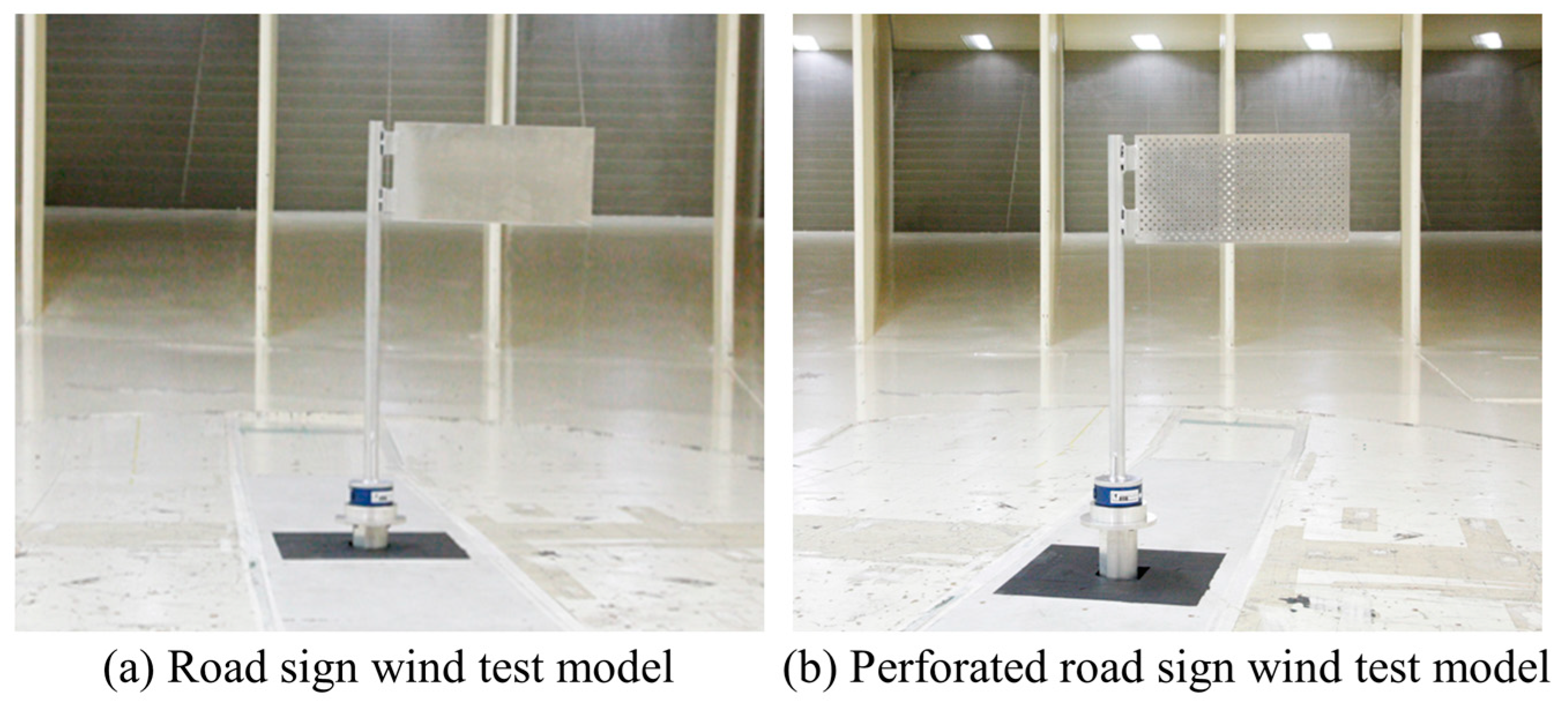



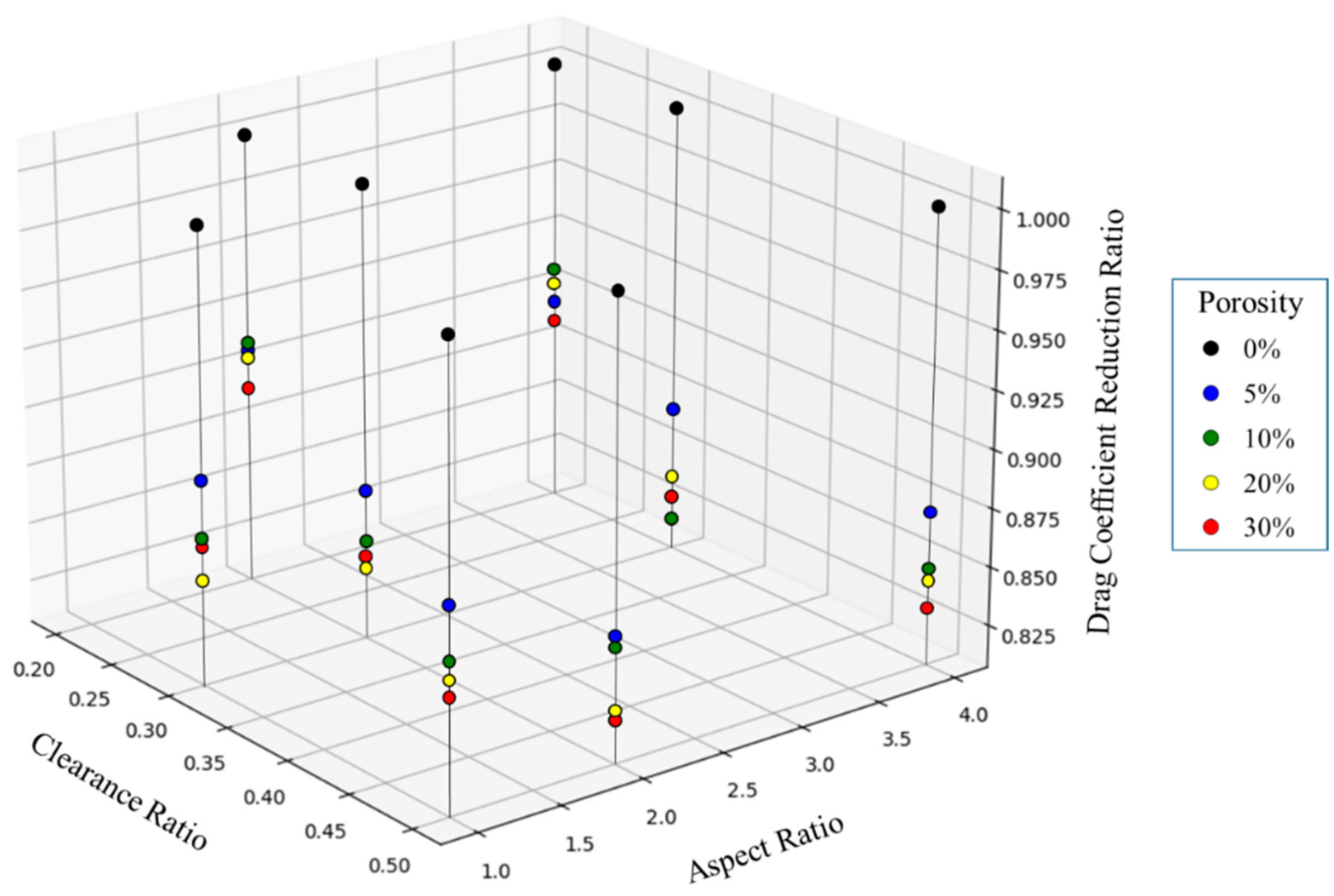
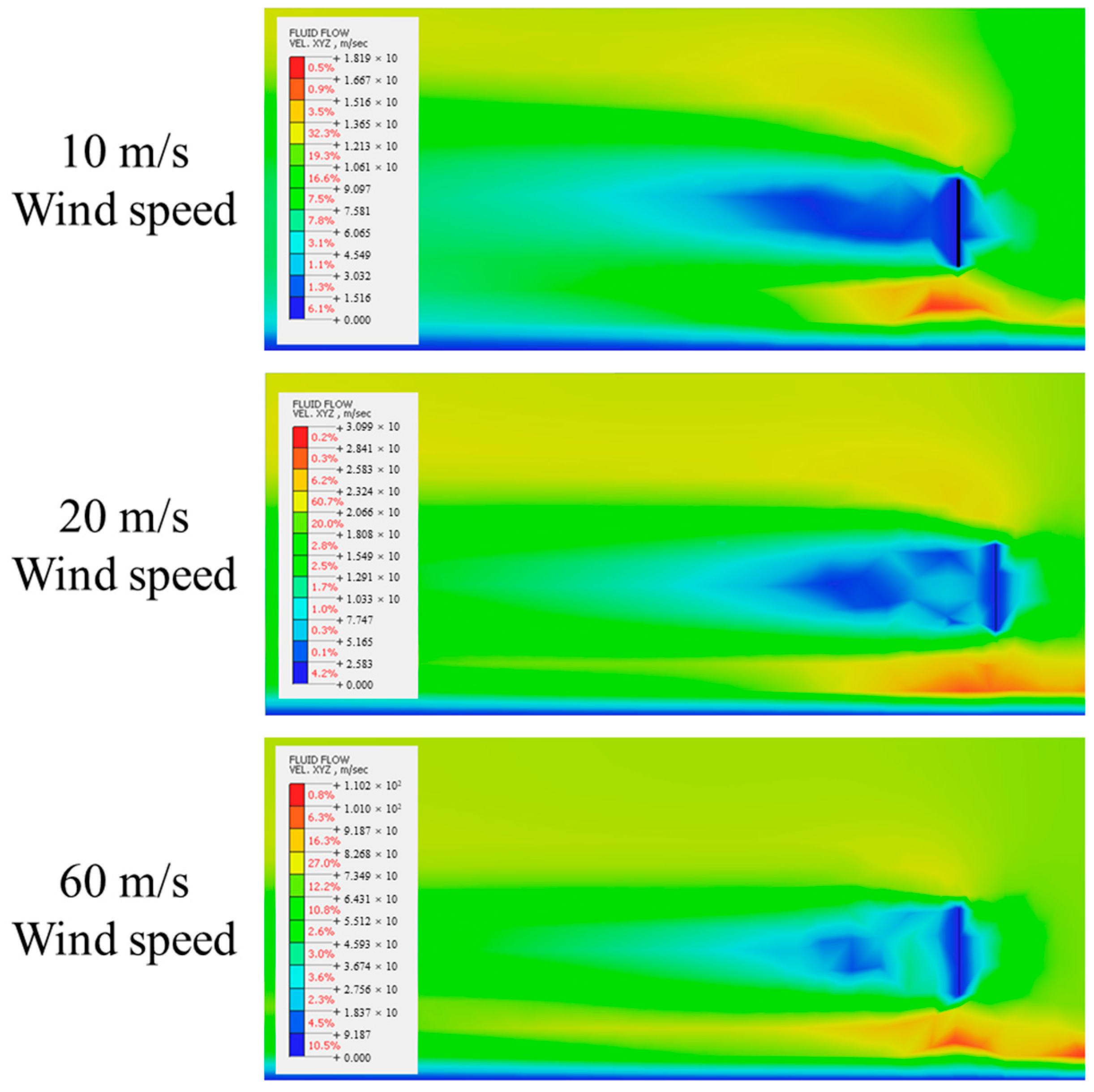

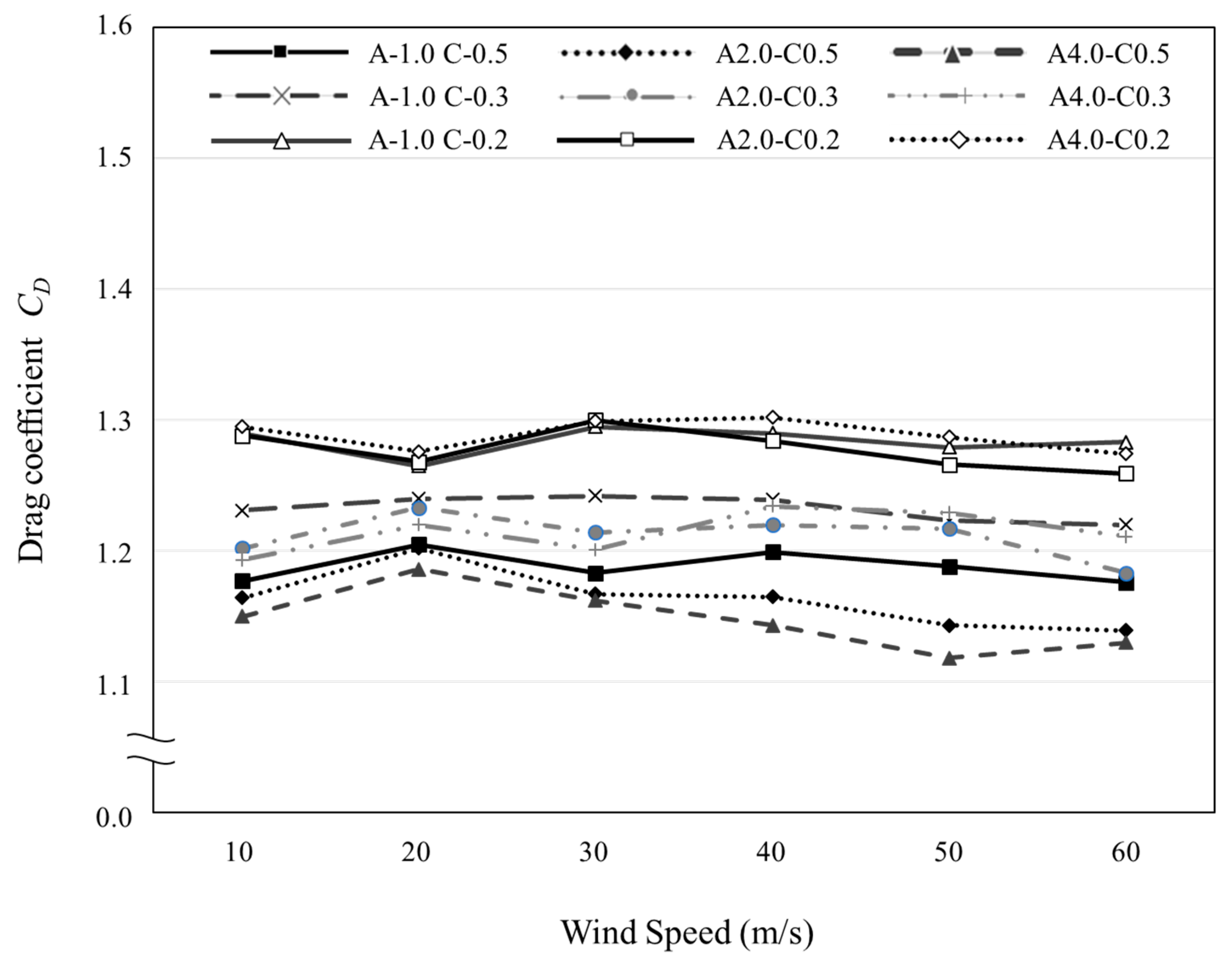
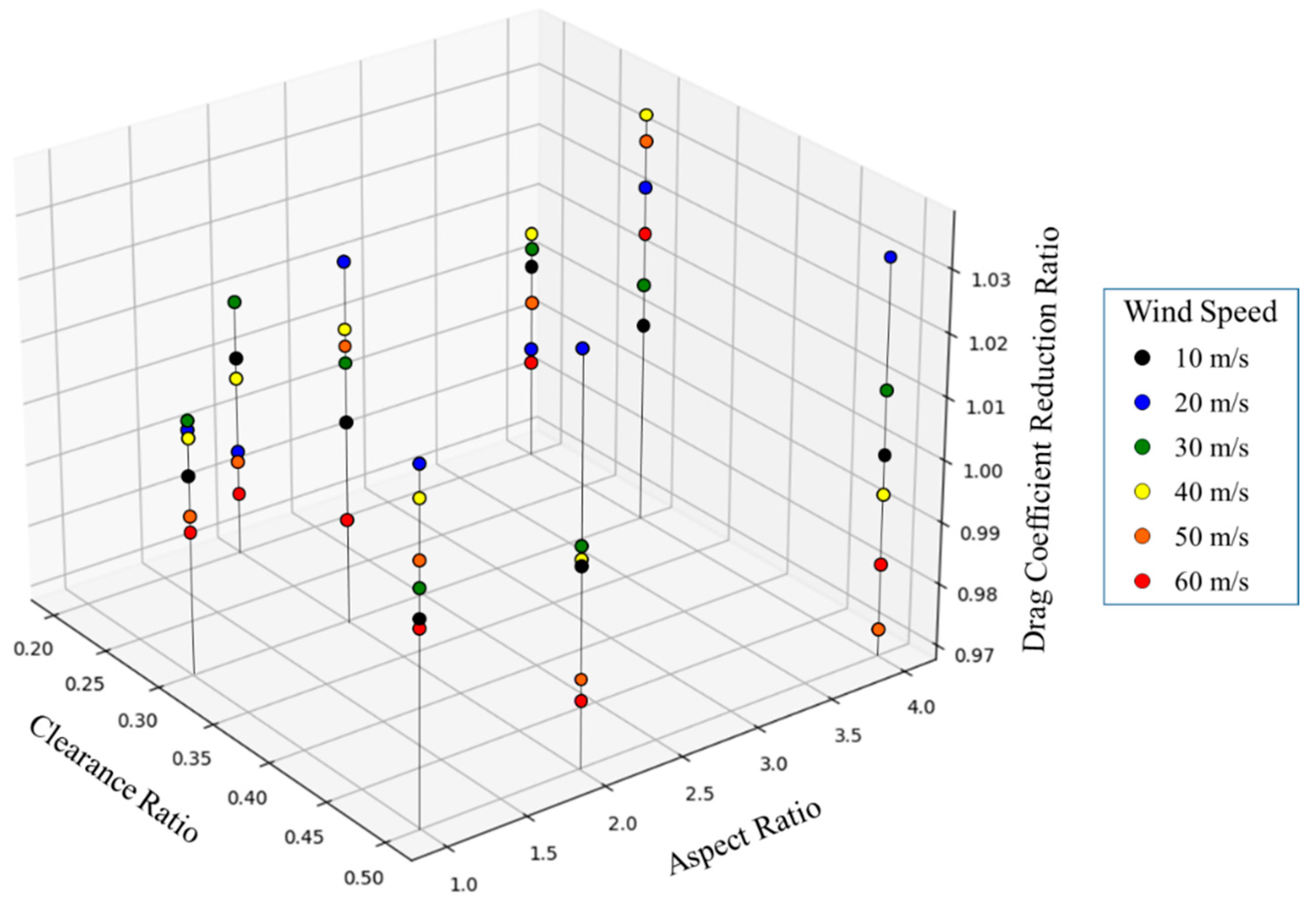
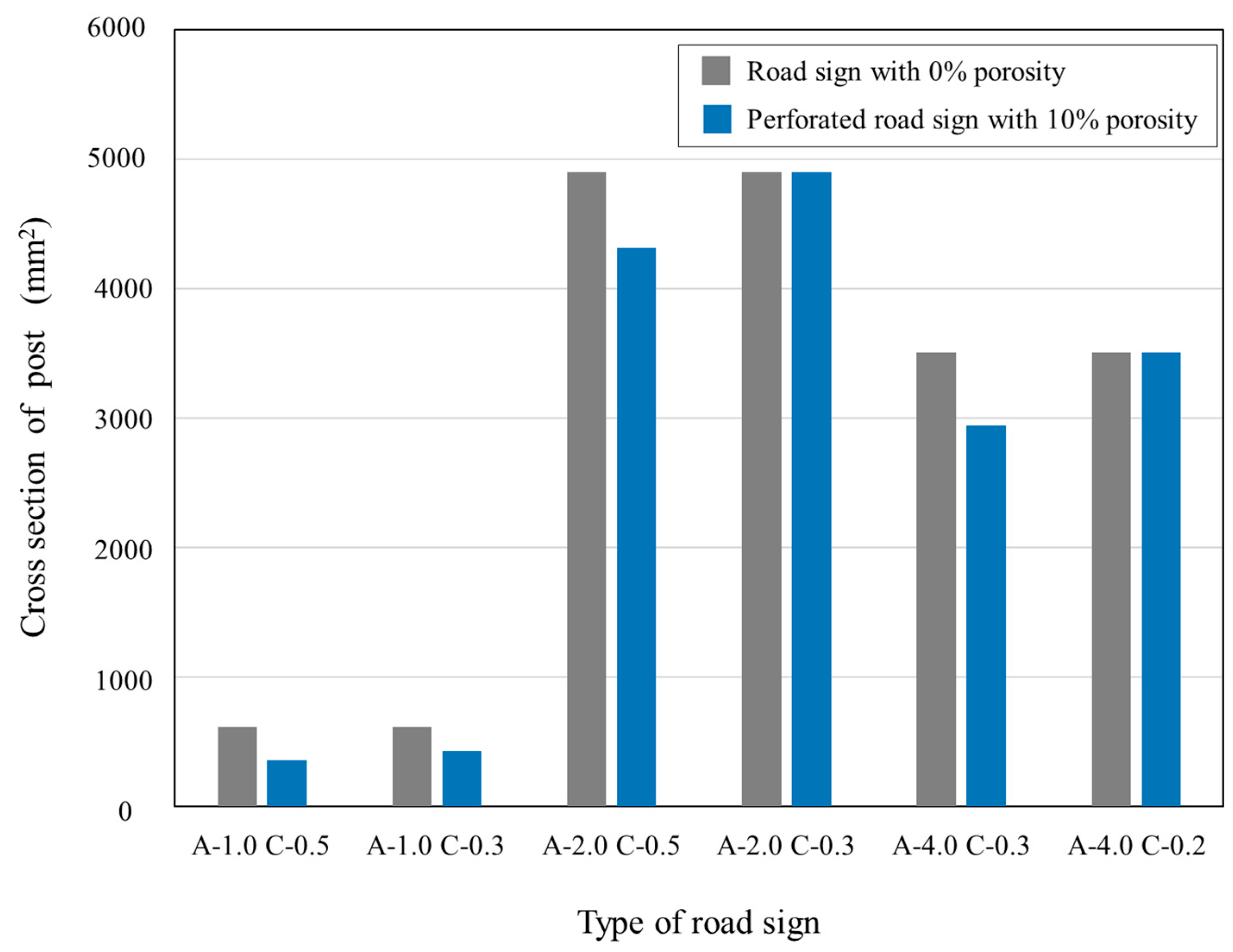
| Property | Unit | Value |
|---|---|---|
| Material | Alloy steel | - |
| Elastic modulus | N/mm2 | 210 |
| Poisson’s ratio | - | 0.28 |
| Tensile strength | N/mm2 | 730 |
| Property | Unit | Value |
|---|---|---|
| Turbulence model | Two-equation k–ε | - |
| Air density | kg/m3 | 1.1845 |
| Viscosity | kg/(m∙s) | 1.8444 × 10−5 |
| Turbulence intensity | % | 5 |
| Turbulence length scale | m | 0.004 |
| Number of iterations | - | 1500 |
| Parameter Name | Aspect Ratio (A) | Clearance Ratio (C) |
|---|---|---|
| A2.0-C0.2 | 2.0 | 0.2 |
| A4.0-C0.2 | 4.0 | |
| A1.0-C0.3 | 1.0 | 0.3 |
| A2.0-C0.3 | 2.0 | |
| A4.0-C0.3 | 4.0 | |
| A1.0-C0.5 | 1.0 | 0.5 |
| A2.0-C0.5 | 2.0 | |
| A4.0-C0.5 | 4.0 |
| Test Type | Wind Speed | Drag Coefficient Reduction Ratio |
|---|---|---|
| Wind tunnel test | 10 m/s | 0.974 |
| 20 m/s | 0.978 | |
| CFD analysis | 10 m/s | 0.911 |
| 20 m/s | 0.900 |
Disclaimer/Publisher’s Note: The statements, opinions and data contained in all publications are solely those of the individual author(s) and contributor(s) and not of MDPI and/or the editor(s). MDPI and/or the editor(s) disclaim responsibility for any injury to people or property resulting from any ideas, methods, instructions or products referred to in the content. |
© 2022 by the authors. Licensee MDPI, Basel, Switzerland. This article is an open access article distributed under the terms and conditions of the Creative Commons Attribution (CC BY) license (https://creativecommons.org/licenses/by/4.0/).
Share and Cite
Sung, H.; Chong, K.; Chung, W. Influence of Porosity on Drag Coefficient of Perforated Road Signs. Appl. Sci. 2023, 13, 502. https://doi.org/10.3390/app13010502
Sung H, Chong K, Chung W. Influence of Porosity on Drag Coefficient of Perforated Road Signs. Applied Sciences. 2023; 13(1):502. https://doi.org/10.3390/app13010502
Chicago/Turabian StyleSung, Hongki, Kyusoo Chong, and Wonseok Chung. 2023. "Influence of Porosity on Drag Coefficient of Perforated Road Signs" Applied Sciences 13, no. 1: 502. https://doi.org/10.3390/app13010502







